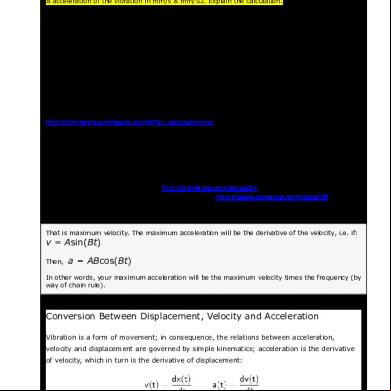Vibration Exciters 5cj3d
This document was ed by and they confirmed that they have the permission to share it. If you are author or own the copyright of this book, please report to us by using this report form. Report 3b7i
Overview 3e4r5l
& View Vibration Exciters as PDF for free.
More details w3441
- Words: 406
- Pages: 11
VIBRATION EXCITERS Submitted by Sivaprasad K.S. MD1107
Introduction A vibration exciter is a machine which produces a mechanical motion to the test object Designed to produce a given range of harmonic or time dependent excitation force and/ or displacement through a given range of frequencies Can be mechanical , electro-dynamic, electrohydraulic, or non- type(electromagnetic) in nature.
Mechanical Exciters Two types – Direct drive and Rotating Unbalance It uses rotating unbalance, usually a pair of contra rotating eccentric masses, to generate a given excitation force or reciprocating follower motion from an eccentric cam or otherwise to generate a given displacement Inexpensive, reliable and easy to operate
Mechanical Exciters The main limitation of mechanical exciters are No control over the force or displacement Limited frequency range
Hydraulic Exciters It uses a piston-cylinder arrangement, the movement of which is controlled by the fluid pressure A wide range of excitation force can be obtained Capable of producing large displacements upto 50cm and also generate a very high force upto 50 tons or more They can generate only very low frequencies Ideally suited for testing civil engineering structures, but not mechanical machines and their components
Electro-dynamic Exciters Most widely used vibration exciter today It consists of a magnet which produces a desired magnetic field , the moving element which forma=s the exciter table on which the test object is mounted, a coil mounted on the moving element fed from an AC source, flexible ing system holding the coil and the moving element in position w.r.t. the magnet
Electro-dynamic Exciters Excitation force is determined by the magnet strength, coil diameter, no. of coil turns and the current ing through the coil.
Electro-dynamic Exciters
An Electro-dynamic Vibration Exciter
Electro-magnetic Exciters Used where a between test specimen and exciter not desired It consists of a coil wound on a strong permanent or a DC electromagnet The test specimen should be of magnet material and is kept at a suitable distance away from the shaker so that no is made between them
Electro-magnetic Exciters The force exerted by the coil on the test specimen is harmonic with the same frequency as that of the current from the oscillator They are very expensive and are heavy and hard to move from place to place between tests Stray magnetic fields creates problem
Introduction A vibration exciter is a machine which produces a mechanical motion to the test object Designed to produce a given range of harmonic or time dependent excitation force and/ or displacement through a given range of frequencies Can be mechanical , electro-dynamic, electrohydraulic, or non- type(electromagnetic) in nature.
Mechanical Exciters Two types – Direct drive and Rotating Unbalance It uses rotating unbalance, usually a pair of contra rotating eccentric masses, to generate a given excitation force or reciprocating follower motion from an eccentric cam or otherwise to generate a given displacement Inexpensive, reliable and easy to operate
Mechanical Exciters The main limitation of mechanical exciters are No control over the force or displacement Limited frequency range
Hydraulic Exciters It uses a piston-cylinder arrangement, the movement of which is controlled by the fluid pressure A wide range of excitation force can be obtained Capable of producing large displacements upto 50cm and also generate a very high force upto 50 tons or more They can generate only very low frequencies Ideally suited for testing civil engineering structures, but not mechanical machines and their components
Electro-dynamic Exciters Most widely used vibration exciter today It consists of a magnet which produces a desired magnetic field , the moving element which forma=s the exciter table on which the test object is mounted, a coil mounted on the moving element fed from an AC source, flexible ing system holding the coil and the moving element in position w.r.t. the magnet
Electro-dynamic Exciters Excitation force is determined by the magnet strength, coil diameter, no. of coil turns and the current ing through the coil.
Electro-dynamic Exciters
An Electro-dynamic Vibration Exciter
Electro-magnetic Exciters Used where a between test specimen and exciter not desired It consists of a coil wound on a strong permanent or a DC electromagnet The test specimen should be of magnet material and is kept at a suitable distance away from the shaker so that no is made between them
Electro-magnetic Exciters The force exerted by the coil on the test specimen is harmonic with the same frequency as that of the current from the oscillator They are very expensive and are heavy and hard to move from place to place between tests Stray magnetic fields creates problem





